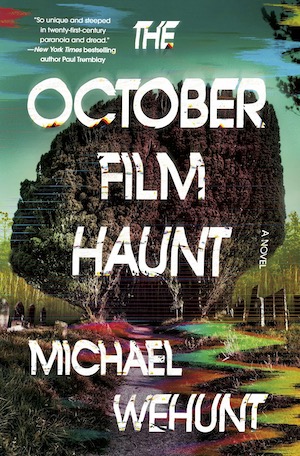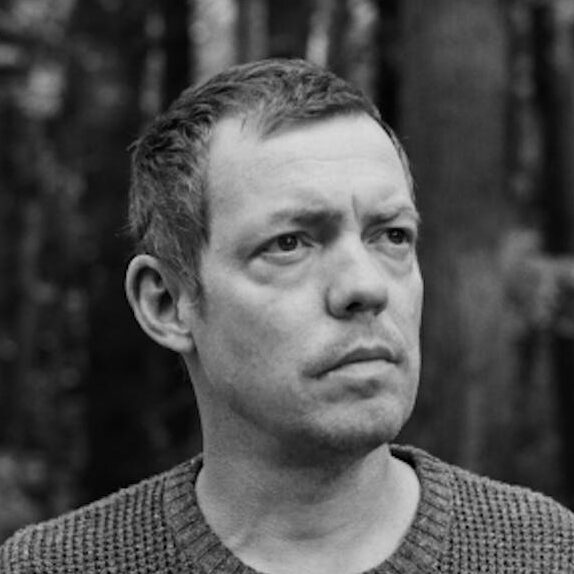
The October Film Haunt
A sense of community, of belonging, is a wonderful feeling. In The October Film Haunt by Michael Wehunt looks at the flipside of craving a tribe; what happens when community becomes a cult, when belonging turns into a fetish, when that emotional high can only be sustained by internet rabbit holes and the like. All of us horror fans get a psychological boost when we mingle with our kind, and author Wehunt smartly plays upon that camaraderie while probing the tenuous boundaries between enthusiasm and dangerous excess. The narrative is canny in referencing horror fandom avatars and for employing meta in a manner guaranteed to amuse the targeted reader. There is much to be admired in Wehunt’s prose, but near the novel’s end I did feel as though I had descended into one of those intractable internet rabbit holes: meta, indeed.
Protagonist Jorie Stroud (recognizable sounding name, yes?) is one of three horror aficionados who film their visits to famous horror movie locations for their trendy blog: “They wanted to capture the essence of the art form they cherished, and to hopefully pick up some of the lingering spirit of the casts and crews, like ectoplasm at a séance.” To help that sentiment along, the trio promote the notion of supernatural activity while on the premises of the exalted 2009 cult film Proof of Demons. This creates a social media frenzy, in large part because of the screenplay’s ambiguity, which leaves much open to interpretation, “Proof of Demons is now as much an urban legend as it is one of the most effective horror movies ever made.” The film’s mysterious director is also factor in the fascination. When one of the website’s followers dies during a pilgrimage to the movie’s cemetery, there’s the inevitable stigma and fallout in consequence.
Jorie and her two friends become platforms recluses, veering away from horror. But, as all who are knowledgeable about the genre are aware, there are certain established plot demands that must be satisfied. Jorie plays out the de rigueur scenarios in her mind, embracing her affinity for the genre: “Still, her eyes are filming, she can’t help but admit this. They still know how to look and frame. How can some part of her, even now, want to step into a horror movie? She already lived one, in her own way, the true crime variety that wounds and grieves and must scab over gradually. She’s the worst kind of final girl, the one who survives because she pointed the main characters into the woods, and the camera followed after them.” Guilt is part of the cinematic horror blueprint.
Ten years ago, Jorie and her spook-hunter companions capitalized on the enduring popularity of Proof of Demons, and paid a price for it. But there is still payment due. Rumors are now surfacing about a sequel, prompting social media reactions such as found footage reminiscent of The Blair Witch Project, and Proof of Demons acolytes decked out in costume homages. Yet there’s more than benign cosplay involved when grotesque murders are cinematically filmed live and distributed to viewer’s devices. Jorie and her associates are among the targets

It is of paramount importance that the reader should care about and relate to the character of Jorie. I mostly did but my favorite character in the story is Roger Eilertsen, a washed-up actor who appeared in Proof of Demons after his career took a dive from its Academy Award nomination apex. At 83 years of age, Roger has now completely succumbed to the agoraphobia that had plagued him for decades: “He began to feel comfort on closed sets, anxiety when he shot open-air scenes. After his early retirement, on trips to buy cursed things for his collection, the agoraphobia began to open in him like starvation.” It rapidly slid into a full-blown psychological compulsion: “Within a year he was like a vampire without a sunset. Close to four decades, eight million dollars, six thousand square feet shrinking down to the size of a coffin, until he wasn’t allowed to feel the grass under his feet and had to rely on hot humming UV bulbs to remind his body that it was supposed to crave the elements like a good animal.” His collection of occult memorabilia grew from his attraction to, and dabbling in, the black arts: “Every failed summoning, every sealed door led him deeper into the search for the arcane, though all he found along the walls of the maze was the profane. Like LaVey’s Satanism or Crowley’s Thelema, it was an excuse for people to be animals, to do what they wilt.” While main character Jorie is interesting and generally sympathetic, in my mind Roger is better delineated and more comprehensible in terms of the actions he takes.
LaVey and Crowley are among the many real-life entities whose names are sprinkled throughout the book, falling within the parameter of the genre. Directors, actors, writers, films, horror publications that exist or had existed, are name-dropped. It is a meta reiteration that becomes a bit redundant. For much of The October Film Haunt, published by St. Martin’s, I was intrigued and absorbed. Michael Wehunt has a very fine writing style and knows how to draw in the reader. As a love letter to the horror genre, the narrative is resplendent. However, I did get the sense that the author was at a loss in how to end the book and was metaphorically treading water while closing in on the denouement. The novel is an apt October seasonal read that drifted close to becoming a classic.

